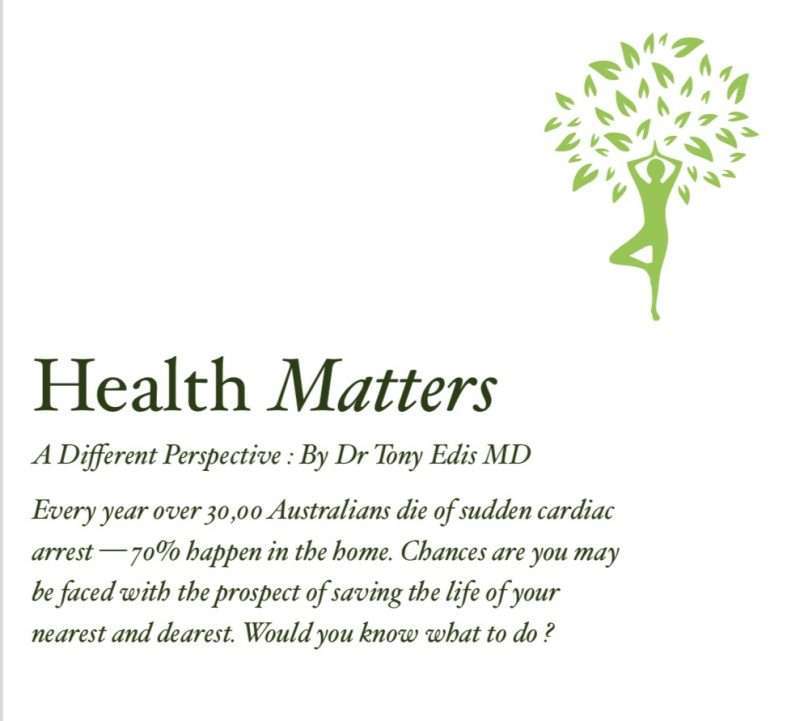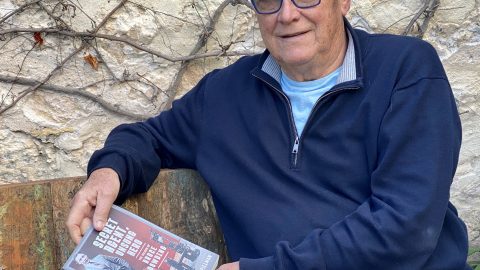
“STAYIN’ ALIVE” – It’s in the beat!
It’s one of the Bee Gees’ most memorable tunes and its catchy beat (100 to 120 /min) is a perfect match for the frequency of performing CPR (Cardiopulmonary Resuscitation) on a victim of sudden cardiac arrest.
As previously discussed in Health Matters #3, coronary heart disease remains the leading cause of mortality in our society. It accounts for most (70 to 85%) of the 30,000 cases of sudden cardiac arrest which occur in Australia each year.
It is a sobering fact that for many individuals with coronary heart disease, the first manifestation of their underlying disease is a sudden cardiac arrest —- they have no premonitory chest pain or other warning symptoms. Hence the call for earlier cholesterol screening, as outlined in my previous article.
So, if you encounter someone who has suddenly collapsed, is non-responsive and is not breathing normally, chances are, he/she is having a heart attack. Other, less frequent causes of sudden death, including electric shock, suffocation, allergic reaction, drowning and drug overdose occur in settings where the the cause is usually apparent.
Unfortunately, most of the victims of sudden cardiac arrest outside of the hospital environment don’t make it — currently, only 10% survive. However, if Cardiopulmonary Resuscitation (CPR) is performed promptly, it can double or triple a person’s chance of recovery — and if a defibrillation electric shock can also be administered by an AED (Automatic External Defibrillator) within 5 minutes or so, the chance of survival can be as high as 75%!

The sad fact is that less than half of the people who suffer a sudden cardiac arrest in an out-of-hospital setting, currently receive bystander CPR. There is vast room for improvement here.
Would you render assistance if you witnessed a cardiac arrest ? Would you have the confidence to use a public access defibrillator? If the answer to these questions is “No” — you should read on.
WHAT IS A CARDIAC ARREST AND HOW DO YOU RECOGNISE IT ?
In a cardiac arrest the heart suffers an electrical malfunction, in most cases due to a blockage or critical narrowing of one of the coronary arteries which provide blood and oxygen to the heart. The heart is no longer able to pump blood properly so blood flow to the brain stops, causing the victim to lose consciousness, collapse and become non responsive (in simple terms, they won’t respond to your shaking their shoulder and asking loudly “Are you OK?”)
Checking for the absence of a pulse is difficult for the uninitiated and is needlessly time-consuming. It should not delay commencing immediate resuscitation. Remember, time is of the essence — every second lost before resuscitation gets underway reduces the chance of recovery by 7 to 10 %.
So get on with it !
* Call 000. The operator will tell you where you can find the nearest AED.
* Have someone retrieve the AED.
* Start CPR.
BYSTANDER CPR — HANDS-ONLY CHEST COMPRESSIONS
Many bystanders who witness an out-of-hospital cardiac arrest in a shopping mall, sporting field or airport etc, cite panic, fear of causing harm, lack of proper training in CPR or worry about contracting infection (especially COVID -19) from mouth-to-mouth ventilation, as reasons for failing to perform CPR.
However, be reassured that –
• any attempt at resuscitation is better than no attempt and that the difference between doing something and doing nothing, could be someone’s life. In the words of Dr Kouwenhoven, who first described the technique of CPR in 1960, “Anyone, anytime, can now initiate cardiac resuscitative measures. All that is needed is two hands”. It is necessary to state unequivocally that effective CPR does not require special training. Anyone can learn the simple steps involved to save a life, and everyone should.
• According to the latest advice, the risk of harm to a victim who receives chest compression when not in cardiac arrest, is virtually negligible. You should also be aware that, in Australia, ‘Good Samaritan’ legislation protects people who go to the assistance of others.
• The concern about contracting infection from mouth-to-mouth ventilation is understandable, especially if the victim has vomited and especially now, during the current COVID epidemic. To counter risks of disease transmission and to encourage more bystander participation in resuscitation efforts, the Australian Resuscitative Council currently recommends a more simplified form of CPR, called Hands-Only CPR , which utilises chest compressions only, without mouth-to mouth breathing, for people suffering out-of- hospital cardiac arrest. This recommendation is based on studies which were carried out under the auspices of the America Heart Association in 2008 showing that there was no difference between 30-day survival with favourable neurological outcome after Hands-Only CPR, when compared with conventional CPR plus assisted ventilation, when carried out on adults who had suffered an out-of-hospital cardiac arrest.
TO PERFORM HANDS-ONLY CPR –
1. Make sure the patient is lying on his/her back on a firm surface.
2. Kneel beside the patient and place the heel of your hand on the centre of the chest.
3. Keep your arms straight locking your elbows and cover the first hand with the heel of your other hand, interlocking the fingers of both hands together.
4. Lean forward so that your shoulders are directly over the chest and press straight down on the chest about 5 cm (2 inches), using your entire body (not just your arms).
5. Release the pressure, but not your hands, and let the chest come back up again.
6. Repeat the compressions 100 times/min —and here the Bee Gees’ tune “Stayin’ Alive” comes into play… you compress the chest to the beat of the song until a defibrillator arrives on the scene.
Perhaps the best and most graphic (if not the most tongue-in-cheek) demonstration of Hands-Only CPR is the YouTube short film produced by the English actor Vinnie Jones and sponsored by the British Heart Association – but do note that the emergency number here in Australia is 000, not 999, as in the video.
CPR is physically exhausting and you will need to be relieved by someone else after 5 to 10 minutes. The sooner a defibrillator can be deployed, the better for the patient … and for the rescuers!
WHAT DOES AN AUTOMATIC EXTERNAL DEFIBRILLATOR (AED) DO?
It is important to understand that CPR may support the circulation and blood flow to the brain for a time but, in and of itself, it will not save most victims of a cardiac arrest. Defibrillation is required.
To explain: in most cases of cardiac arrest the heart is not pumping effectively because it has an abnormal rhythm (if you could actually see the heart it would would appear to be shivering or shaking rather than rhythmically contracting like a healthy heart). The heart is said to be in ventricular fibrillation (VF), or ventricular tachycardia (VT). The heart has to be electrically shocked, or defibrillated, using an AED to get it back to a normal and effective pumping rhythm.
The sooner defibrillation is attempted, the better the chance of restoring a normal cardiac rhythm and the higher the survival rate. It is well known that if defibrillation is combined with CPR within 3 minutes of collapse it can lead to survival rates as high as 75%. But for every minute of delay between the arrest and defibrillation, the chance of survival decreases by 10%. Given that the average response time of an ambulance in the metropolitan area is 12 to 14 minutes, if you wait for the ambulance AED to get there, the chance of survival could be as low as 5%.
These stark figures are behind the recent push by various governments and national Heart Associations to make “public access” AED’s more widely available. This program has been highly successful, with the familiar white cabinets housing AED’s now seen everywhere, just like fire extinguishers, in shopping centres, gyms, sporting clubs, railway stations, airports, aircraft, sports stadiums and various other public spaces.Somewhat surprisingly, however, most GP clinics in Australia are still not equipped with AEDs.
The need for more AEDs in GP clinics was highlighted by a recent study in the Medical Journal of Australia (July, 2021) of 126 cases of cardiac arrests which had occurred in Victorian GP clinics over the past 20 years. The study revealed that the likelihood of survival was more than twice as high for clinic patients for whom the first shock was administered by clinic staff with an onsite AED, rather than if it was provided by arriving paramedics. But, it was telling that more than half of the patients had to await the arrival of paramedics before they could be defibrillated, because the clinic did not have an AED.
While cardiac arrest may be a relatively uncommon event in most GP clinics, 2 out of 3 people experiencing a heart attack will contact their GP rather than call an ambulance, either because they are unsure, or because they think that they have a low risk of actually having one. Knowing that public access AEDs are now available in locations such as Woolworths and Coles supermarkets, most patients would nowadays expect a GP practice to have the necessary equipment, should such an emergency arise.
HOW TO OPERATE AN AED – DON’T BE SCARED, IT’S SIMPLE!
Just like fire extinguishers, public access AEDs are designed to be used by any member of the public. It is vitally important that they should be readily accessible. Any delay in fetching an AED, or obtaining a code to unlock the cabinet containing the AED, may reduce the chance of saving a person’s life or of preventing any long term neurological impairment.
Using an AED is quite straightforward and we all need to be made aware of how easy it is to use one. When you switch the defibrillator on, it will provide clear instructions and will talk you through what you need to do. Many modern AEDs also incorporate a video display screen providing visual prompts for the next step.
You don’t need to worry that an AED will cause harm to the person you’re trying to resuscitate. It will only give them a shock if and when it is needed.
There’s no reason to feel nervous about using a defibrillator — just follow its simple instructions, and feel confident in the knowledge that using it could save someone’s life.
Put simply, THE STEPS TO USE AN AED ARE AS FOLLOWS –
• “Remove clothing from patient’s chest”.
• “Apply the electrode pads to the patient’s bare chest, exactly as shown in the pictures on the pads”.The electrodes have sensors in them. It will take 5 to 10 seconds for the defibrillator to analyse the heart’s rhythm and to charge up.
• The AED will then announce that it is prepared to give a shock — but only if the electrodes pick up a “shockable” abnormal heart rhythm such as ventricular fibrillation (VF), or ventricular tachycardia (VT). A Fully Automatic AED is designed to give the jolt automatically and will also give a voice prompt reminding rescuers not to touch the patient immediately before the shock is delivered. If possible, wear latex gloves, (usually provided with the AED) so you are less likely to get a shock, but in any event you should only feel a slight tingle. A Semi Automatic AED will prompt rescuers to press the “SHOCK” button if a shock is needed. These devices have now been mainly superseded by the fully automatic type of AED.
• After rendering a defibrillation shock, the AED will prompt the rescuer to give the patient CPR for two minutes, counting down the time on the screen. After two minutes, the AED will again prompt the rescuers not to touch the patient while it checks the heart rhythm to determine if another shock is required. The AED will continue to provide prompts as required. These should be followed until advance life support (ie, paramedics) arrive and are ready to provide further treatment.
So we have come a full circle back to the beginning.
Having made the case that AEDs are so effective and so simple and safe to use, could one justify expanding their availability beyond the public space to the home setting ? After all, 70% of cardiac arrests happen at home and a significant number of them will occur in individuals with unsuspected coronary heart disease. With the cost of an AED now less than that of the average TV set (in Australia, the price of an automatic defibrillator machine start from as little as $1,300), would it be too far-fetched to suggest that an AED might constitute a worthwhile investment as another home appliance which can be added to the first aid kit, to be available (like a fire extinguisher) in case of dire emergency ?
Households including persons in the older age bracket or with risk factors for heart disease (especially a prior history of heart attack or angina, or a strong family history of heart disease) might be more likely to consider such a purchase – it could be a life saver.
* This article was written by Anthony J Edis MB, BS, (Hons), MD, FACS, FRACS
PLEASE HELP US TO GROW FREMANTLE SHIPPING NEWS
FSN is a reader-supported, volunteer-assisted online magazine all about Fremantle. Thanks for helping to keep FSN keeping on!
In case you missed Dr Edis MD’s previous articles here they are –
* #1 Intermittent Fasting trend
* #2 dealt with the Food Guide Pyramid and dietary fat.
* #3 discussed the ‘Lowdown’ on cholesterol and statins







